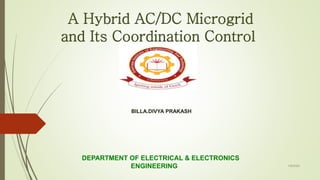
A Hybrid AC/DC Micro grid and Its Coordination Control
- 1. A Hybrid AC/DC Microgrid and Its Coordination Control 1/8/2020 DEPARTMENT OF ELECTRICAL & ELECTRONICS ENGINEERING BILLA.DIVYA PRAKASH
- 2. Abstract The microgrid concept introduces the reduction of multiple conversions in an individual AC or DC grid and also facilitates connections to variable renewable AC and DC sources and loads to power system. Here photovoltaic system, wind turbine generator and battery are used for the development of microgrid. Also control mechanisms are implemented for the converters to properly coordinate the AC grid to DC grid. We are implementing this project by using Simulink(MATLAB) software. 1
- 3. Contents Aim of the project. Introduction to Microgrid. Conventional Grid versus Microgrid. Power plants interconnected to Microgrid. Block Diagrams. Simulation Diagram. Simulation results. Advantages of Micro Power generation. Conclusion. References. 1/8/2020 2
- 4. Aim of the Project To supply the reliable quality power with lowest unit price. Generation of noiseless &pollution free electrical power. 1/8/2020 3
- 5. Introduction Microgrid A microgrid is a localized grouping of electricity generation, energy storage, and loads that normally operates connected to a traditional centralized grid (Conventional grid). It is a small scale power supply network that is designed to provide power for a small community. It enables local power generation for loads. The Need Of Microgrid: 1.Transmission losses are highly reduced. 2. Provide high quality and reliable energy supply to critical loads. 4
- 6. Microgrid VS Conventional grid 6 •Efficiency: High •Power sources: Are small and nearer to loads. •Wastage: Very few amount of energy can wasted. •Cost: Lower design cost •Size: Smaller in size •Efficiency: Low •Power sources: Are large and far to loads. •Wastage: Large amount of energy can wasted in the form of heat. •Cost: Higher design cost •Size: Bigger in size 5
- 7. PV Panel Working of PV Panel6
- 9. AC/DC Microgrid And Its Coordination Control8
- 11. Simulation Diagram of PV panel10
- 12. Simulation Diagram of wind turbine11
- 13. Simulation Diagram of Hybrid AC/DC Microgrid and Its Coordination Control 12
- 14. Simulation results of Hybrid AC/DC Microgrid System 13
- 15. Terminal voltage of solar panel 1. Grid-Connected Mode14 0 2 4 6 8 10 12 x10 4 250 260 270 280 290 300 310 time(s) voltage
- 16. PV output power versus solar irradiation 15 0 2 4 6 8 10 12 14 x 10 4 0 0.5 1 1.5 2 2.5 3 3.5 4 x 10 4 time(S) power(W),irradiation(W/m2)
- 17. AC side voltage and current of the main converter with variable solar irradiation level and constant DC load 16 0 2 4 6 8 10 12 x 10 4 -80 -60 -40 -20 0 20 40 60 80 time(S) voltage(V) current(I)
- 18. DC bus voltage transient response 17 0 2 4 6 8 10 12 x 10 4 0 50 100 150 200 250 300 350 400 450 Time(S) voltage(V)
- 19. AC side voltage and current of the main converter with constant solar Irradiation level and variable dc load 18 0 2 4 6 8 10 12 x 10 4 -80 -60 -40 -20 0 20 40 60 80 Time(S) voltage(V) current(A)
- 20. Output power of the doubly fed induction generator 19 0 2 4 6 8 10 12 x 10 4 0 0.5 1 1.5 2 2.5 3 3.5 x 10 4 Time(s) PowerofDFIG(KW)
- 21. AC side voltage versus current 20 0 2 4 6 8 10 12 x 10 4 -80 -60 -40 -20 0 20 40 60 80 Time(S) PowerofDFIG(KW)
- 22. 2. Isolated Mode21 0 2 4 6 8 10 12 x 10 4 -60 -50 -40 -30 -20 -10 0 10 20 30 40 Time(S) current(A) 0 2 4 6 8 10 12 x 10 4 79.999 79.9995 80 80.0005 80.001 80.0015 80.002 80.0025 80.003 80.0035 80.004 Time(S) SOC
- 23. 22 0 2 4 6 8 10 12 14 x 10 4 0 50 100 150 200 250 300 350 400 450 Time(S) voltage(V)
- 24. 23 DC Bus voltage 0 2 4 6 8 10 12 14 x 10 4 -0.5 0 0.5 1 1.5 2 2.5 3 3.5 4 x 10 4 Time(S) power(KW) PV output Power 0 2 4 6 8 10 12 14 x 10 4 0 10 20 30 40 50 60 70 Time(S) current(A) Battery current
- 25. Advantages Of Micro Power generation Low cost Simple expansion of the system Simplified supervisory control Increase reliability Increased quality of service 24
- 26. Conclusion A microgrid with the integration of PV and wind systems is developed using MATLAB/Simulink and also discussed the results of individual and interconnected operation. this work is to develop intelligent power management system and also a coordination control between the converters is needed to reduce the processes of multiple AC-DC or DC-AC conversions. The AC/DC microgrid can provide a reliable, high quality and more efficient power to consumer. The microgrid maybe feasible for small isolated industrial plants with both PV systems and wind turbine generator as the major power supply. 25
- 27. References 1. R. H. Lasseter, “Micro Grids,” in Proc. IEEE Power Eng. Soc. Winter Meet., Jan. 2002, vol. 1, pp. 305–308. 2. Y. Zoka, H. Sasaki, N. Yorino, K. Kawahara, and C. C. Liu, “An interaction problem of distributed generators installed in a Micro Grid,” in Proc. IEEE Elect. Utility Deregulation, Restructuring. Power Technol., Apr. 2004, vol. 2, pp. 795–799. 3. R. H. Lasseter and P. Paigi, “Micro grid: A conceptual solution,” in Proc. IEEE 35th PESC, Jun. 2004, vol. 6, pp. 4285–4290. 4. C. K. Sao and P. W. Lehn, “Control and power management of converter fed Micro Grids,” IEEE Trans. Power Syst., vol. 23, no. 3, pp. 1088–1098, Aug. 2008. 5. T. Logenthiran, D. Srinivasan, and D.Wong, “Multi-agent coordination for DER in Micro Grid,” in Proc. IEEE Int. Conf. Sustainable Energy Technol., Nov. 2008, pp. 77–82. 26
- 28. 1/8/2020 27
- 29. 1/8/2020 28
